| Author: | |
| Website: | |
| Page title: | |
| URL: | |
| Published: | |
| Last revised: | |
| Accessed: |
| Year: | 1984 |
| Original platform: | Elektronika 60 |
| Brief description: | Dynamic puzzle game |
| Number of players: | One |
| Developers/contributors: | Alexéy Pájitnov / Vadim Gerasimov / Dmitry Pavlovsky |
Tetris is probably one of the most addictive computer games in the history of computer gaming. The modern origins of Tetris, however, go back at least as far as the beginning of the twentieth century. The underlying concept is based on mathematical puzzle games in which geometric shapes are used to completely fill a square or rectangular area without leaving any gaps. The precise origins of such puzzles are a matter for speculation, but they could well date back hundreds, or even thousands of years. The particular class of puzzle in which we are interested involves geometric shapes called polyominoes. A polyomino is a two-dimensional shape consisting of an arrangement of n squares of uniform size. Each square must have at least one edge in common with one of the other squares. The word polyomino is an abstraction of the word domino, the name given to the rectangular tiles used in the game dominoes, each of which consists of two squares (the game of dominoes itself is thought to have originated in China during the thirteenth century CE).
The kind of polyomino we are interested in with respect to common mathematical puzzles is called a pentomino. As the name suggests, a pentomino is a shape created using five squares of uniform size, arranged in the manner previously described. The name pentomino, along with the names of other polyominos, is believed to have been coined by the American mathematician and professor of electrical engineering Solomon W Golomb, who reportedly introduced the name in a talk given to the Harvard Mathematics Club in 1953. Of course, the shapes themselves had been around for a lot longer.
One of the earliest known puzzles involving pentominoes appeared in a mathematical puzzle book published in 1907 entitled The Canterbury Puzzles and Other Curious Problems, written by English author and mathematician Henry Dudeny. In all, there are eighteen pentominoes. Of these, twelve are referred to as free pentominoes, which means that they cannot be obtained by rotating, reflecting or translating one of the other free pentominoes. Each of the remaining six shapes is a mirror image of one of the free pentominoes. By convention, each of the free pentominoes is named using the letter of the alphabet which it most closely resembles.
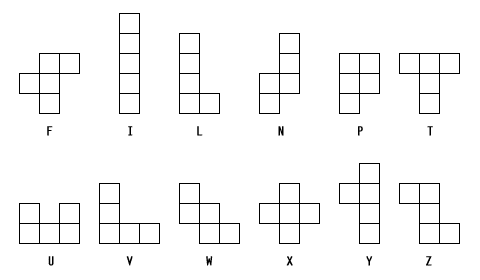
The twelve free pentominoes
In some cases, it is fairly easy to see the correlation between the shape of the pentomino and the letter after which it is named. For the shapes labelled N, X and Y, you need to picture the shape rotated forty-five degrees clockwise. For the shapes labelled V and W, you need to imagine the shape rotated forty five degrees anti-clockwise. The remaining six pentominoes are reflections of the free pentominoes F, L, N, P, Y and Z. They are by convention labelled F', J, N', Q, Y' and S, and are called chiral pentominoes. This means that they are not identical to their mirror images, and therefore cannot be mapped to their mirror images using rotation or translation alone.

The six chiral pentominoes
Common pentomino puzzles usually involve completely filling a rectangular space using pentominoes. In one common puzzle of this type, the rectangular space must occupy sixty squares. The rules state that each pentomino shape must be used exactly once, and no gaps should be left in the rectangular space. Some examples are shown below. Note that, since all of the shapes consist of identical squares, we have used different colours to differentiate between them. Note also that it is a particular property of pentominoes that a complete set of twelve pentominoes containing no duplicates (i.e. one and only one of each type of pentomino) can be used to fill a rectangle completely, with no gaps or overlaps. This is not true of other polyominoes such as (for example) hexominoes (polyominoes consisting of six squares) or tetrominoes (polyominoes consisting of four squares). Similar types of puzzle do not exist for these shapes, simply for that reason.
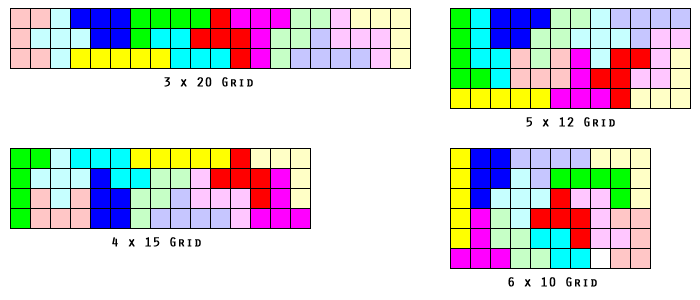
A set of twelve pentominoes containing no duplicates can completely fill a rectangular area
Those of you who are familiar with Greek (or at least with the use of Greek words to prefix the names of regular geometric shapes) will of course realise that a game called "Tetris" is unlikely to feature pentominoes, since tetra in Greek means "four". You may also have surmised that the game will feature tetrominoes, which are of course polyominoes made up of four identical squares. If you have ever played Tetris, you will probably appreciate that using pentominoes would make the game very much harder to play, whereas using trominoes (polyominoes formed using three squares) would make it far too easy. Using tetrominoes, we have a sufficiently large set of shapes to make the game challenging, without making it virtually unplayable. The complete set of tetrominoes is shown below. Note that the colours we have used for each shape conform to the standard laid down by The Tetris Company (more about them later). Note also that the shapes labelled J and L are mirror images of one another, as are the shapes labelled S and Z.

The seven tetrominoes
It is perhaps not particularly surprising that a video game based on mathematical puzzles of the kind described above emerged for arcade machines, game consoles and personal computers. What is somewhat unusual is that this particular game was developed in the former Soviet Union, at a time when most game development was taking place either in the United States or Japan. The idea for Tetris came from Moscow-born computer engineer Alexéy Leonídovich Pájitnov. When the game first appeared during the summer of 1984 Pájitnov, who was twenty-eight years old at the time, was working for the Dorodnitsyn Computing Centre of the Soviet Academy of Sciences (CCAS), a Soviet research and development establishment. The computer hardware on which Pájitnov initially developed the game was an Elektronika 60, which was essentially a Russian clone of the Programmed Data Processor (PDP) mini-computer manufactured by the Digital Equipment Corporation (DEC). In that respect, the hardware was very similar to that used to create the landmark game Spacewars! at MIT in 1962.
Pájitnov was aided in his efforts by friend and fellow computer engineer Dmitry Pavlovsky (who had himself designed several games on mainframe computers) and sixteen-year-old high-school student Vladimir Gerasimov (who at the time of writing is working as an engineer with Google). Gerasimov was working at the computing centre as part of his school computer science studies, and came to the attention of Pavlovsky whilst working on a directory encryption program for DOS on an IBM PC. It was Pavlovsky who introduced him to Pájitnov, presumably because all three had an interest in developing computer games. Pájitnov is said to have come up with the name Tetris by combining the first part of the word tetromino and the last part of the word tennis (apparently he was a big tennis fan). Due to the limitations of the Elektronika 60's hardware, the game's "graphics" were created using ASCII characters. The tetrominoes, for example, were produced using pairs of square brackets grouped together.
In the game itself, tetrominoes appear in a central position at the top of the screen one at a time and fall, slowly at first, down a vertical shaft. In versions written for the IBM PC and other personal computers, the player uses various keys on the keyboard to move each tetromino left or right, to change the orientation of the tetromino (by rotation), or to cause the tetromino to fall immediately to the bottom of the shaft. The rate of descent is such that each tetromino falls through a distance equivalent to the height of one square in a pre-determined time interval. Once the tetromino is at the bottom of the shaft its orientation cannot be changed, and it cannot be moved left or right. The idea of the game is to try to ensure that the blocks fall in such a way that the bottom row is filled with squares. If this is achieved, the complete row of squares will disappear, causing anything resting on top of it to fall by one row, and creating space for incoming tetrominoes. In some cases, more than one row can be completed at the same time, up to a maximum of four. All completed rows will disappear, and any rows lying above them will move down to fill the gap that is left.
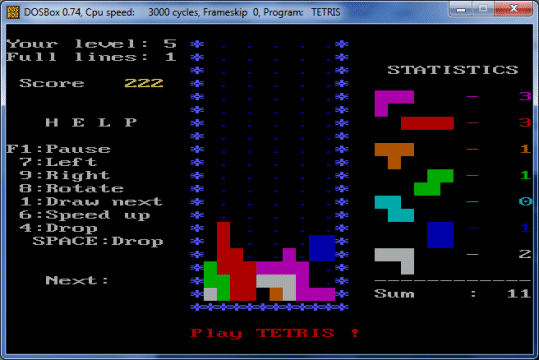
The original IBM PC version of Tetris, available from Vadim Gerasimov's website
(http://vadim.oversigma.com)
Although hundreds of versions of Tetris have been produced over the years, most follow the same basic format. The playing area (the shaft or well) is ten squares wide by twenty squares high. The tetrominoes (of which there are seven different types) appear in a random order. Each sideways move by the player shifts the tetromino left or right by one square, and each re-orientation rotates the tetromino through an angle of ninety degrees clockwise. A row is complete when every available square space on that row is occupied by one square component of a tetromino. If the player fails to clear the rows quickly enough, the tetrominoes will eventually stack to the top of the shaft, and the game is over. Tetris is one of those games which at first sight looks relatively easy but turns out to be quite taxing. The object of the game is usually grasped by first time players immediately, without the need for lengthy explanations. The combination of simple rules and the relentless challenge presented by the game have the effect of making it highly addictive.
The game enters a new level after a given number of rows have been cleared. This usually means that more points are awarded for clearing rows, but it also means that the tetrominoes will fall faster. The player therefore has less time to position the tetrominoes, and it becomes harder to prevent them from stacking up to the top of the shaft (this is sometimes referred to as "topping out"), which of course ends the game. Once a player is happy with the lateral and rotational orientation of the current tetromino, they can use the designated keystroke to make the tetromino drop into position immediately. The player also has the option of seeing a preview of the next tetromino scheduled to appear at the top of the shaft. The preview facility gives the player the advantage of being able to plan their next move in advance, but may also mean that fewer points are awarded.
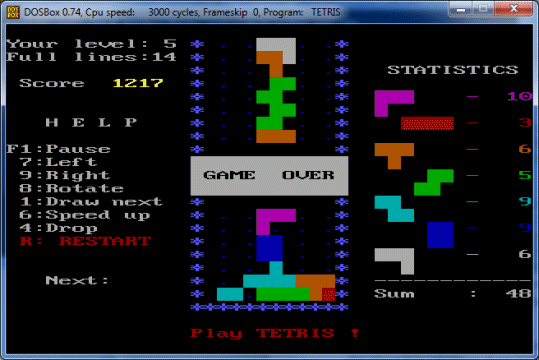
If the tetrominoes are allowed to stack to the top of the shaft, it's game over
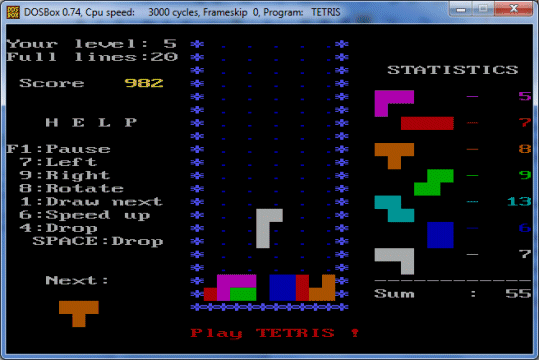
The player can choose to see a preview of the next tetromino to fall (bottom left)
Although the way in which points are awarded varies considerably between different versions of the game, most implementations award a certain number of points for each row cleared. Additional points are usually awarded for clearing multiple rows in a single move, and the number of points awarded usually increases with each level. As you can see from the above screenshot, the original DOS version of the game has a relatively small number of commands available. Rotation of the tetromino is always clockwise, and the preview function is limited to the next tetromino to fall. The player's current score, level and total number of lines cleared is displayed at the top of the screen on the left hand side. Statistics detailing the number and type of blocks encountered are shown at the right-hand side.
The version of Tetris illustrated above is a DOS version written for the IBM PC by Vadim Gerasimov. It is available for download free of charge from Gerasimov's website. Pájitnov had originally intended to sell the computer games produced by himself, Pavlovsky and Gerasimov, but attempts to do so met with failure. Private enterprise was, after all, hardly the sort of thing that was encouraged in the former Soviet Union. Instead, the three would-be entrepreneurs ended up giving free copies of their games, including Tetris, to friends and associates. These friends and associates passed the software on to others, and Tetris began to appear on computers all over Moscow. Within a relatively short time, it was being played all over the Soviet Union. Tetris eventually found its way to the Hungary Institute of Technology, where programmers working for the institute created versions for other personal computer systems, including the Apple II and Commodore 64. It was here that the game first came to the attention of a representative from the mainstream gaming industry, Robert Stein.
In 1986, Stein was visiting the Hungary Institute of Technology in his capacity as a director of Andromeda Software, a British software publishing company that had strong links with the Eastern Bloc. Stein saw Tetris, and immediately recognised its potential. The copyright notice on the software led Stein to contact the CCAS in Moscow to try and obtain rights for the game. CCAS, with no previous experience of setting up this kind of deal, assigned Alexéy Pájitnov the task of negotiating with him. Stein allegedly offered Pájitnov an advance of one hundred thousand pounds sterling for the rights to publish the game for home computers, and received a response from Pájitnov indicating that the Computing Centre would be interested in coming to some arrangement. On the strength of this exchange, and with absolutely nothing agreed in writing, Stein sold the UK rights for the personal computer version of Tetris to software publishing company Mirrorsoft, which was owned by Robert Maxwell's company Pergamon Holdings. He sold the US rights to Spectrum Holobyte, a US software publishing company based in Alameda, California. Interestingly enough, this company was also later acquired by Robert Maxwell.
What followed was a somewhat chaotic series of events. Indeed, it is difficult to know exactly what happened, as different accounts tell somewhat different stories. Suffice it to say that both Mirrorsoft and Spectrum Holobyte were working under the impression that they had acquired legal rights to publish and distribute Tetris, an impression which at that time was completely false. Late in 1986, Stein sent a contract to the CCAS and even flew to Moscow to ensure that it was signed. Unfortunately for him, the Russians were not prepared to be steamrollered into signing anything until they could assure themselves that they were getting the best possible deal. Frustrated, Stein allegedly tried to circumvent the Russians by making a deal with the Hungarian programmers who had been responsible for porting the game to other platforms. Whether or not this is true, there is no record of any deal being struck in Budapest. Meanwhile both Mirrorsoft and Spectrum Holobyte were making plans to release Tetris for various personal computer platforms, including the IBM PC, Commodore 64, Atari ST, Amiga, and Apple II.
Spectrum Holobyte's IBM PC version of the game was released in the US in 1987. It featured background images that reflected the fact that the game had originated in the USSR. This version of the game is featured in the screenshot below, and is available for download from the AbandonwareDos website. In the same year, Robert Stein finally secured a licensing agreement from Pájitnov that allowed Andromeda to publish and distribute Tetris for the IBM PC and other personal computers. Unfortunately for him, it turned out that Pájitnov was somewhat exceeding his authority in this respect. At that time, the only organisation actually authorised to sell software originating in the Soviet Union to a foreign buyer was Elektronorgtechnica (usually abbreviated to ELORG). Stein found himself having to renegotiate with ELORG for rights he thought he had already secured, and which he had already sold to various third parties. In the first half of 1988, after protracted negotiations with ELORG director Alexander Alexinko, Stein eventually secured the rights to publish and distribute Tetris for personal computers. The agreement explicitly excluded rights to produce arcade and hand-held game console versions.
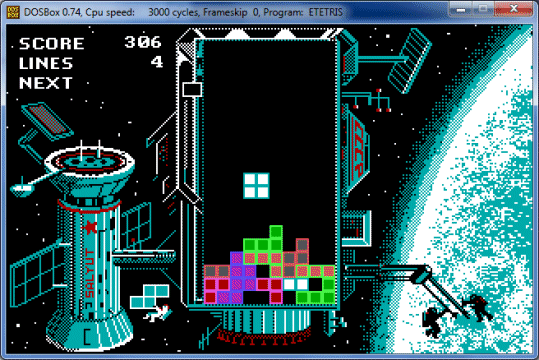
Spectrum Holobyte's DOS version of Tetris depicted various Russian themes
(http://www.abandonwaredos.com)
Later in the same year, Stein was still trying to negotiate with ELORG for the home console, handheld, and arcade rights. This time around he was dealing with Nikoli Belikov, who had been assigned by ELORG to re-examine, and if necessary re-negotiate, the existing contract. Belikov was also empowered to negotiate new contracts. He was not particularly impressed by the fact that Andromeda Software (Stein's company) had not fulfilled their contractual obligations to ELORG, having failed to comply with the agreed payment terms. Meanwhile, another player had entered the story. Henk Rogers was born in the Netherlands in 1953 but spent much of his early life in New York. He moved to Japan in the late 1970s and established his own software publishing company, Bullet Proof Software. Rogers became involved in the story after seeing a prototype version of Tetris in January 1988 at the Consumer Electronics Show held in Las Vegas. He recognised the enormous potential of the game immediately.
Rogers was well aware that Nintendo were about to release their new handheld console Gameboy, and felt that Tetris would be the ideal game to bundle with it. He initially approached Robert Stein to try to negotiate the rights for the handheld version of Tetris, mistakenly believing that Stein held those rights (which of course he didn't). It should be pointed out at this point that Bullet Proof Software believed they had already obtained the rights to produce game console and home computer versions of Tetris in Japan from Spectrum Holobyte, who in turn believed they had obtained those rights from Stein. Bullet proof Software consequently produced a version of Tetris for Nintendo's Famicom console (Famicom, short for Family Computer, is the name under which the Nintendo Entertainment System was marketed in Japan). To complicate matters even further, Mirrorsoft had sold exactly the same rights to Atari for both the Japanese and North American markets. Tengen (a subsidiary of Atari Games specifically set up to produce game software for the console market) had produced its own console version of Tetris for the Famicom. The resulting legal battles between Nintendo and Atari would drag on until 1993.
After several months of negotiating with Stein and getting nowhere, Rogers had had enough. He resolved to try and negotiate directly with ELORG. Stein, probably realising what Rogers was planning, decided to fly to Moscow to secure the handheld and console rights for Tetris. Meanwhile Mirrorsoft, who had no doubt begun to question the legitimacy of the rights they had obtained from Stein (and which they had already sub-licensed to Atari), were also planning a more direct approach. As it turned out, Henk Rogers, Robert Stein and Kevin Maxwell (Robert Maxwell's son, representing Mirrorsoft) all arrived in Moscow during the same week in February 1989. Rogers somehow managed to get to see Nikoli Belikov before either of his rivals. The meeting produced some unexpected revelations for both men. Belikov was taken aback when Rogers presented him with a Famicom cartridge version of Tetris. Rogers was equally surprised when Belikov informed him that the console rights for Tetris had so far not been licensed to anybody.
The result of the meeting was that Belikov's suspicions, that Robert Stein had not been entirely honest with him, were confirmed. His assessment of Henk Rogers, on the other hand, led him to believe that here was someone with whom he would be happy to do business. Kevin Maxwell was not too well received, probably because of Robert Maxwell's ongoing efforts to use his (not inconsiderable) political influence to put pressure on ELORG via his contacts in the Soviet government. To cut a long (and very complicated) story short, Rogers walked away with the handheld rights for Tetris. Stein retained the personal computer rights, but with a much more tightly defined contract that spelled out exactly what could and could not be considered a "personal computer" under the terms of the contract. He also reportedly obtained the arcade rights. Maxwell walked away with nothing other than the option to make an offer on any rights for Tetris that had not already been assigned.
As stated above, Stein supposedly came away from his meeting with Belikov with the arcade game rights for Tetris. This information appears to contradict sources that claim that the arcade rights had already been awarded to Atari during the previous year (1988). Atari Games certainly released an arcade version of Tetris in 1988, but there appears to be no hard information concerning how exactly they acquired the rights allowing them to do so. Since there is also no mention of Atari having entered into any direct negotiations with ELORG, these rights were presumably the subject of a deal between Atari and Mirrorsoft, or perhaps between Atari and Robert Stein. Atari do not appear to have faced any legal challenges concerning the arcade version of Tetris, as far as we can ascertain.
Having secured the handheld rights on behalf of Nintendo, Rogers proposed a similar deal to Nintendo for the console rights. In March 1989 Nintendo, via Rogers, made ELORG an offer which was duly accepted. Mirrorsoft did not attempt to match the offer. Having secured sole rights for the console version of Tetris, Nintendo demanded that Atari cease production and sales of their console version. After a brief and unsuccessful legal challenge, Atari were forced to accede to Nintendo's demands, leaving them with an estimated one hundred thousand unsold and now worthless game cartridges. Although the legal wrangling between Atari and Nintendo would continue for some time, Nintendo (and Bullet Proof Software) would ultimately be triumphant. Several million copies of Nintendo's version of Tetris were sold for the Nintendo Entertainment System, while the handheld version of Tetris bundled with the Gameboy helped Nintendo to achieve sales of over thirty million Gameboy units.
While all of this was going on the man behind Tetris, Alexéy Pájitnov, had received no financial reward for his efforts, even though the game had assured him a place in computer gaming history. He had, however, formed a lasting friendship with Henk Rogers. In 1991, Rogers helped him and his family to emigrate to the United States, where they found a new home in Seattle. In 1996, Pájitnov joined Microsoft as a games software developer. In the same year, the rights to Tetris reverted from the Russian state back to Pájitnov. With financial backing largely provided by Henk Rogers, Pájitnov and Rogers set up The Tetris Company. The name Tetris was registered as a trademark in the US (and most other countries in the world) through Pájitnov and Rogers' new company. The company claimed to hold the copyright for all products bearing the Tetris name in the United States. Pájitnov finally began to earn royalties for his creation, and had taken back a measure of control.
Today, Tetris can be found on every conceivable computing platform. It is estimated, for example, that some ten percent of all games sold for mobile phones in the United States are some variant of Tetris. Almost everyone you meet will have played some version of Tetris at least once in their life. Playing Tetris has been shown to have a positive effect on cognitive processes, and has even been suggested as a possible form of therapy for psychiatric conditions such as post-traumatic stress disorder (PTSD). The Tetris Company itself is currently striving to make greater inroads into the online gaming market, and has taken steps to protect its interests in that area by threatening, and in some cases implementing, legal action against online entities that it deems guilty of copyright or trademark infringement. The company has set up a website, http://www.tetrisfriends.com, in an attempt to create an online community of Tetris players. The website promotes competitive online social gaming, which is of course centred around a number of Tetris game variants.